Management Accounting Report: Processes, Techniques, and Evaluation
VerifiedAdded on 2021/01/03
|17
|5119
|319
Report
AI Summary
This report delves into the core concepts of management accounting, exploring its processes, techniques, and applications within a business context. It begins by defining management accounting and its role in organizational planning, control, and decision-making, contrasting it with financial accounting. The report then examines various management accounting tools such as cost accounting systems (normal costing, standard costing), job costing, and inventory management techniques (FIFO, LIFO, weighted average). It further analyzes different types of managerial accounting reports, including budget reports, accounts receivable reports, and inventory management reports, emphasizing their importance for informed decision-making. The report also evaluates the benefits of using a management accounting system and critically assesses different accounting reporting techniques, culminating in a discussion of financial issues and the balance scorecard method. The content includes a table of contents, introduction, task-based analysis, and conclusion, providing a comprehensive overview of management accounting principles and practices. The report concludes by evaluating financial issues and the balance scorecard method.
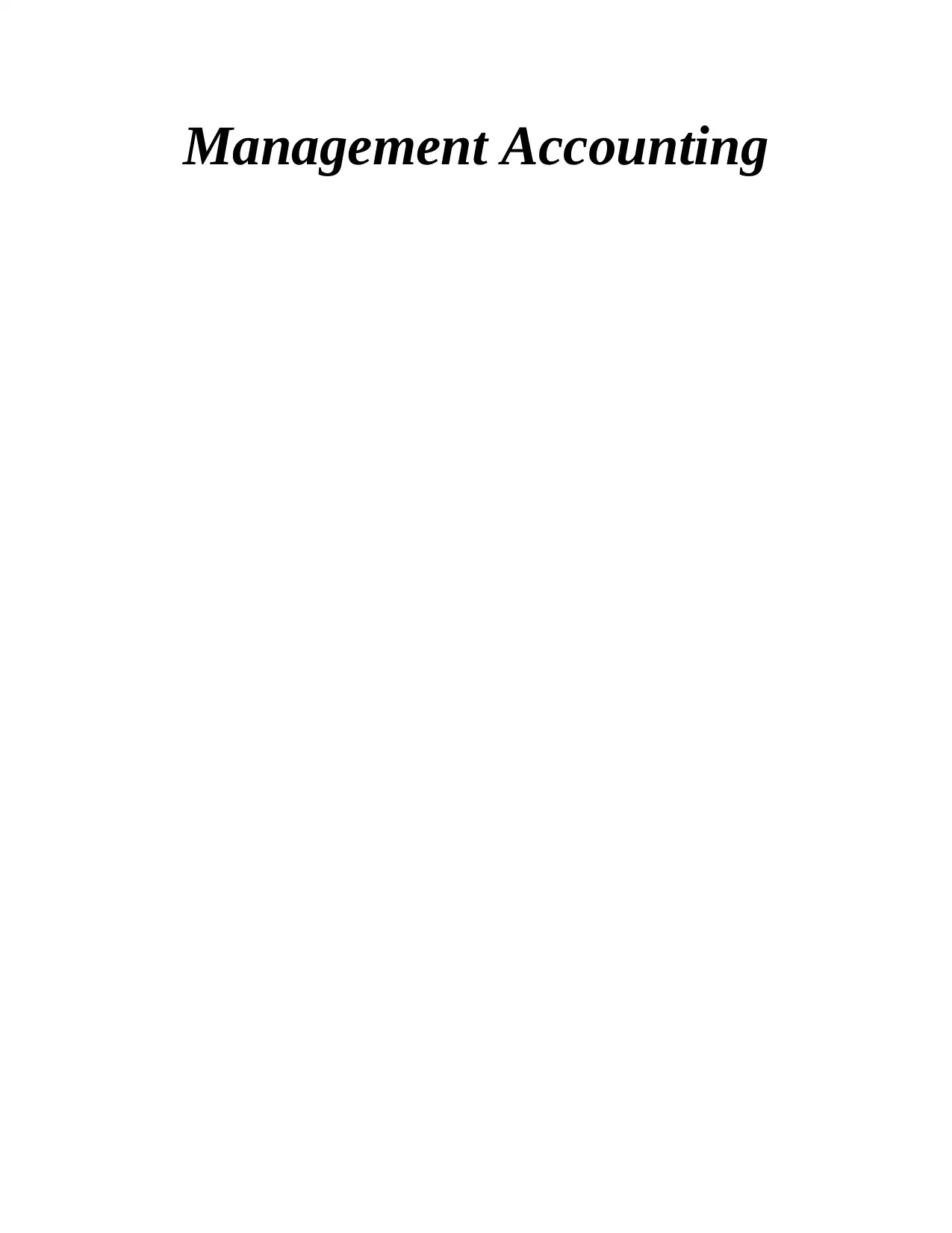
Management Accounting
Paraphrase This Document
Need a fresh take? Get an instant paraphrase of this document with our AI Paraphraser
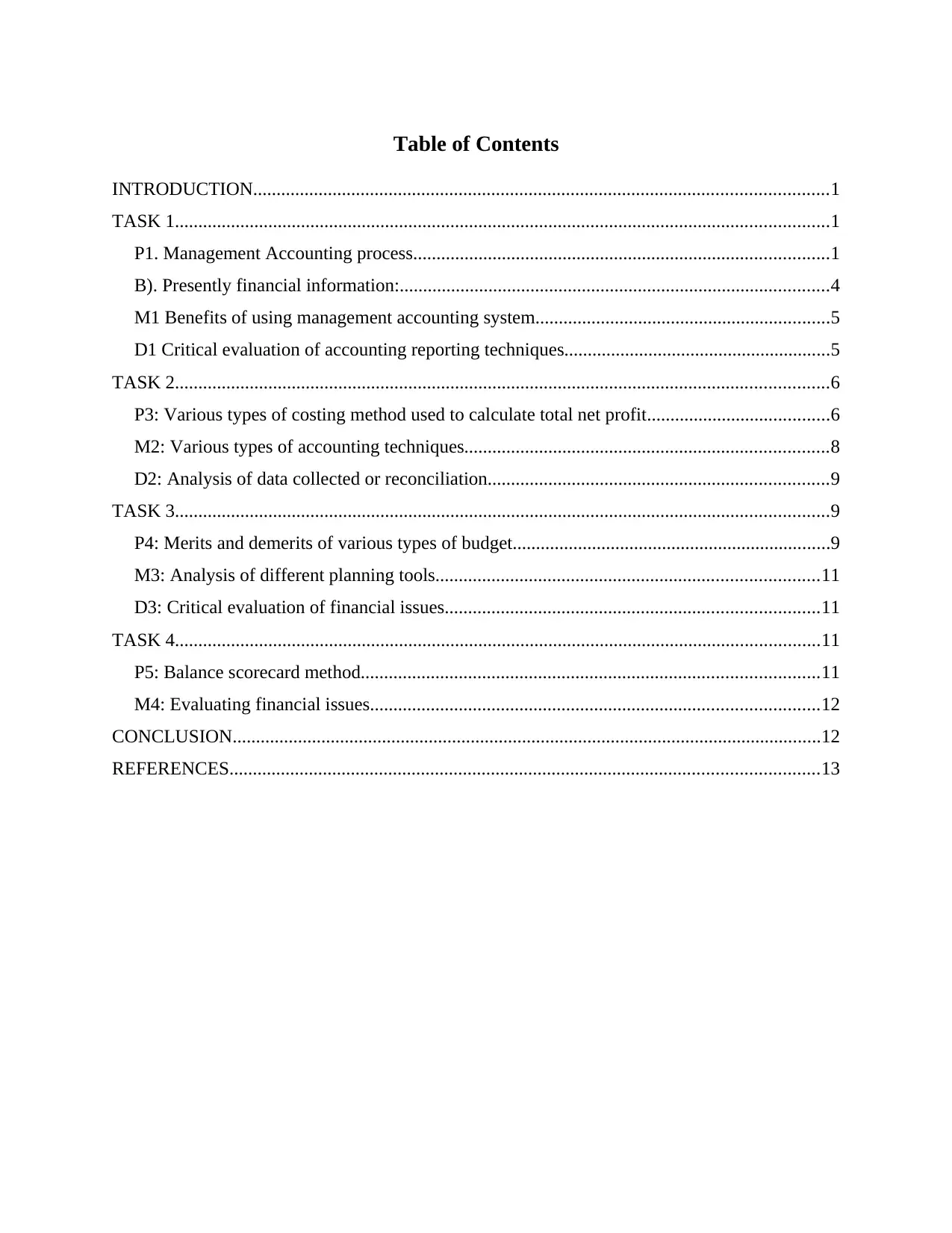
Table of Contents
INTRODUCTION...........................................................................................................................1
TASK 1............................................................................................................................................1
P1. Management Accounting process.........................................................................................1
B). Presently financial information:............................................................................................4
M1 Benefits of using management accounting system...............................................................5
D1 Critical evaluation of accounting reporting techniques.........................................................5
TASK 2............................................................................................................................................6
P3: Various types of costing method used to calculate total net profit.......................................6
M2: Various types of accounting techniques..............................................................................8
D2: Analysis of data collected or reconciliation.........................................................................9
TASK 3............................................................................................................................................9
P4: Merits and demerits of various types of budget....................................................................9
M3: Analysis of different planning tools..................................................................................11
D3: Critical evaluation of financial issues................................................................................11
TASK 4..........................................................................................................................................11
P5: Balance scorecard method..................................................................................................11
M4: Evaluating financial issues................................................................................................12
CONCLUSION..............................................................................................................................12
REFERENCES..............................................................................................................................13
INTRODUCTION...........................................................................................................................1
TASK 1............................................................................................................................................1
P1. Management Accounting process.........................................................................................1
B). Presently financial information:............................................................................................4
M1 Benefits of using management accounting system...............................................................5
D1 Critical evaluation of accounting reporting techniques.........................................................5
TASK 2............................................................................................................................................6
P3: Various types of costing method used to calculate total net profit.......................................6
M2: Various types of accounting techniques..............................................................................8
D2: Analysis of data collected or reconciliation.........................................................................9
TASK 3............................................................................................................................................9
P4: Merits and demerits of various types of budget....................................................................9
M3: Analysis of different planning tools..................................................................................11
D3: Critical evaluation of financial issues................................................................................11
TASK 4..........................................................................................................................................11
P5: Balance scorecard method..................................................................................................11
M4: Evaluating financial issues................................................................................................12
CONCLUSION..............................................................................................................................12
REFERENCES..............................................................................................................................13

⊘ This is a preview!⊘
Do you want full access?
Subscribe today to unlock all pages.

Trusted by 1+ million students worldwide
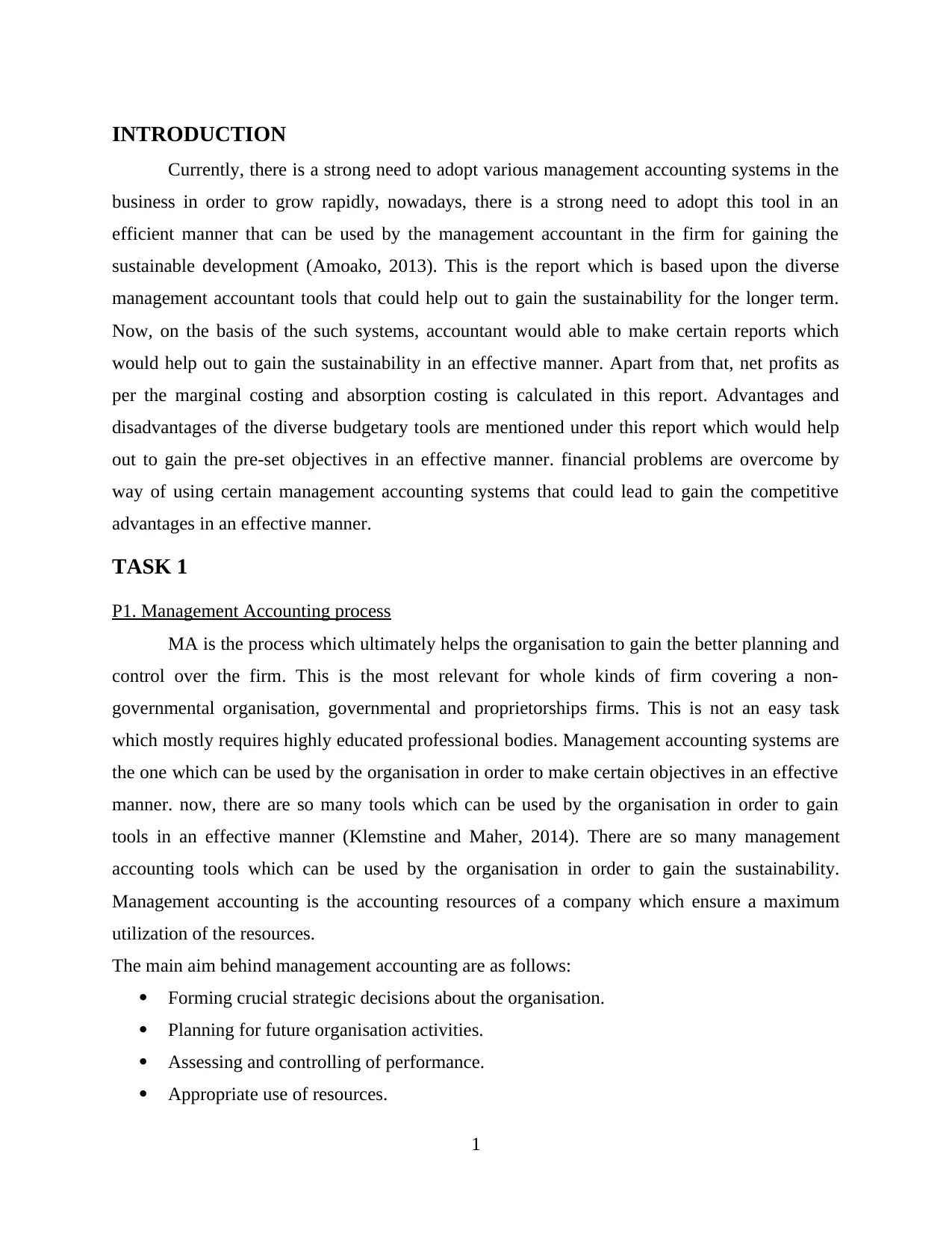
INTRODUCTION
Currently, there is a strong need to adopt various management accounting systems in the
business in order to grow rapidly, nowadays, there is a strong need to adopt this tool in an
efficient manner that can be used by the management accountant in the firm for gaining the
sustainable development (Amoako, 2013). This is the report which is based upon the diverse
management accountant tools that could help out to gain the sustainability for the longer term.
Now, on the basis of the such systems, accountant would able to make certain reports which
would help out to gain the sustainability in an effective manner. Apart from that, net profits as
per the marginal costing and absorption costing is calculated in this report. Advantages and
disadvantages of the diverse budgetary tools are mentioned under this report which would help
out to gain the pre-set objectives in an effective manner. financial problems are overcome by
way of using certain management accounting systems that could lead to gain the competitive
advantages in an effective manner.
TASK 1
P1. Management Accounting process
MA is the process which ultimately helps the organisation to gain the better planning and
control over the firm. This is the most relevant for whole kinds of firm covering a non-
governmental organisation, governmental and proprietorships firms. This is not an easy task
which mostly requires highly educated professional bodies. Management accounting systems are
the one which can be used by the organisation in order to make certain objectives in an effective
manner. now, there are so many tools which can be used by the organisation in order to gain
tools in an effective manner (Klemstine and Maher, 2014). There are so many management
accounting tools which can be used by the organisation in order to gain the sustainability.
Management accounting is the accounting resources of a company which ensure a maximum
utilization of the resources.
The main aim behind management accounting are as follows:
Forming crucial strategic decisions about the organisation.
Planning for future organisation activities.
Assessing and controlling of performance.
Appropriate use of resources.
1
Currently, there is a strong need to adopt various management accounting systems in the
business in order to grow rapidly, nowadays, there is a strong need to adopt this tool in an
efficient manner that can be used by the management accountant in the firm for gaining the
sustainable development (Amoako, 2013). This is the report which is based upon the diverse
management accountant tools that could help out to gain the sustainability for the longer term.
Now, on the basis of the such systems, accountant would able to make certain reports which
would help out to gain the sustainability in an effective manner. Apart from that, net profits as
per the marginal costing and absorption costing is calculated in this report. Advantages and
disadvantages of the diverse budgetary tools are mentioned under this report which would help
out to gain the pre-set objectives in an effective manner. financial problems are overcome by
way of using certain management accounting systems that could lead to gain the competitive
advantages in an effective manner.
TASK 1
P1. Management Accounting process
MA is the process which ultimately helps the organisation to gain the better planning and
control over the firm. This is the most relevant for whole kinds of firm covering a non-
governmental organisation, governmental and proprietorships firms. This is not an easy task
which mostly requires highly educated professional bodies. Management accounting systems are
the one which can be used by the organisation in order to make certain objectives in an effective
manner. now, there are so many tools which can be used by the organisation in order to gain
tools in an effective manner (Klemstine and Maher, 2014). There are so many management
accounting tools which can be used by the organisation in order to gain the sustainability.
Management accounting is the accounting resources of a company which ensure a maximum
utilization of the resources.
The main aim behind management accounting are as follows:
Forming crucial strategic decisions about the organisation.
Planning for future organisation activities.
Assessing and controlling of performance.
Appropriate use of resources.
1
Paraphrase This Document
Need a fresh take? Get an instant paraphrase of this document with our AI Paraphraser
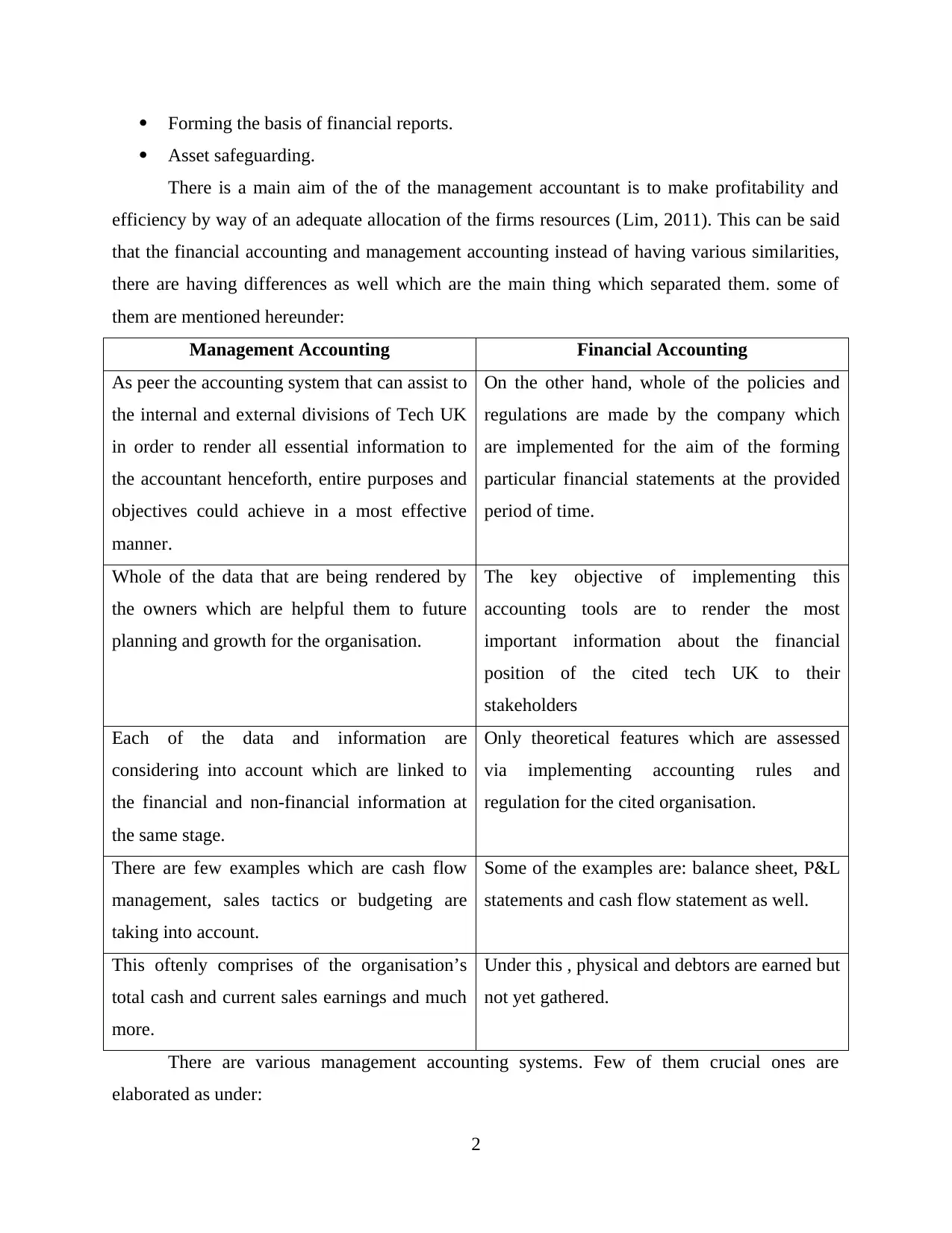
Forming the basis of financial reports.
Asset safeguarding.
There is a main aim of the of the management accountant is to make profitability and
efficiency by way of an adequate allocation of the firms resources (Lim, 2011). This can be said
that the financial accounting and management accounting instead of having various similarities,
there are having differences as well which are the main thing which separated them. some of
them are mentioned hereunder:
Management Accounting Financial Accounting
As peer the accounting system that can assist to
the internal and external divisions of Tech UK
in order to render all essential information to
the accountant henceforth, entire purposes and
objectives could achieve in a most effective
manner.
On the other hand, whole of the policies and
regulations are made by the company which
are implemented for the aim of the forming
particular financial statements at the provided
period of time.
Whole of the data that are being rendered by
the owners which are helpful them to future
planning and growth for the organisation.
The key objective of implementing this
accounting tools are to render the most
important information about the financial
position of the cited tech UK to their
stakeholders
Each of the data and information are
considering into account which are linked to
the financial and non-financial information at
the same stage.
Only theoretical features which are assessed
via implementing accounting rules and
regulation for the cited organisation.
There are few examples which are cash flow
management, sales tactics or budgeting are
taking into account.
Some of the examples are: balance sheet, P&L
statements and cash flow statement as well.
This oftenly comprises of the organisation’s
total cash and current sales earnings and much
more.
Under this , physical and debtors are earned but
not yet gathered.
There are various management accounting systems. Few of them crucial ones are
elaborated as under:
2
Asset safeguarding.
There is a main aim of the of the management accountant is to make profitability and
efficiency by way of an adequate allocation of the firms resources (Lim, 2011). This can be said
that the financial accounting and management accounting instead of having various similarities,
there are having differences as well which are the main thing which separated them. some of
them are mentioned hereunder:
Management Accounting Financial Accounting
As peer the accounting system that can assist to
the internal and external divisions of Tech UK
in order to render all essential information to
the accountant henceforth, entire purposes and
objectives could achieve in a most effective
manner.
On the other hand, whole of the policies and
regulations are made by the company which
are implemented for the aim of the forming
particular financial statements at the provided
period of time.
Whole of the data that are being rendered by
the owners which are helpful them to future
planning and growth for the organisation.
The key objective of implementing this
accounting tools are to render the most
important information about the financial
position of the cited tech UK to their
stakeholders
Each of the data and information are
considering into account which are linked to
the financial and non-financial information at
the same stage.
Only theoretical features which are assessed
via implementing accounting rules and
regulation for the cited organisation.
There are few examples which are cash flow
management, sales tactics or budgeting are
taking into account.
Some of the examples are: balance sheet, P&L
statements and cash flow statement as well.
This oftenly comprises of the organisation’s
total cash and current sales earnings and much
more.
Under this , physical and debtors are earned but
not yet gathered.
There are various management accounting systems. Few of them crucial ones are
elaborated as under:
2
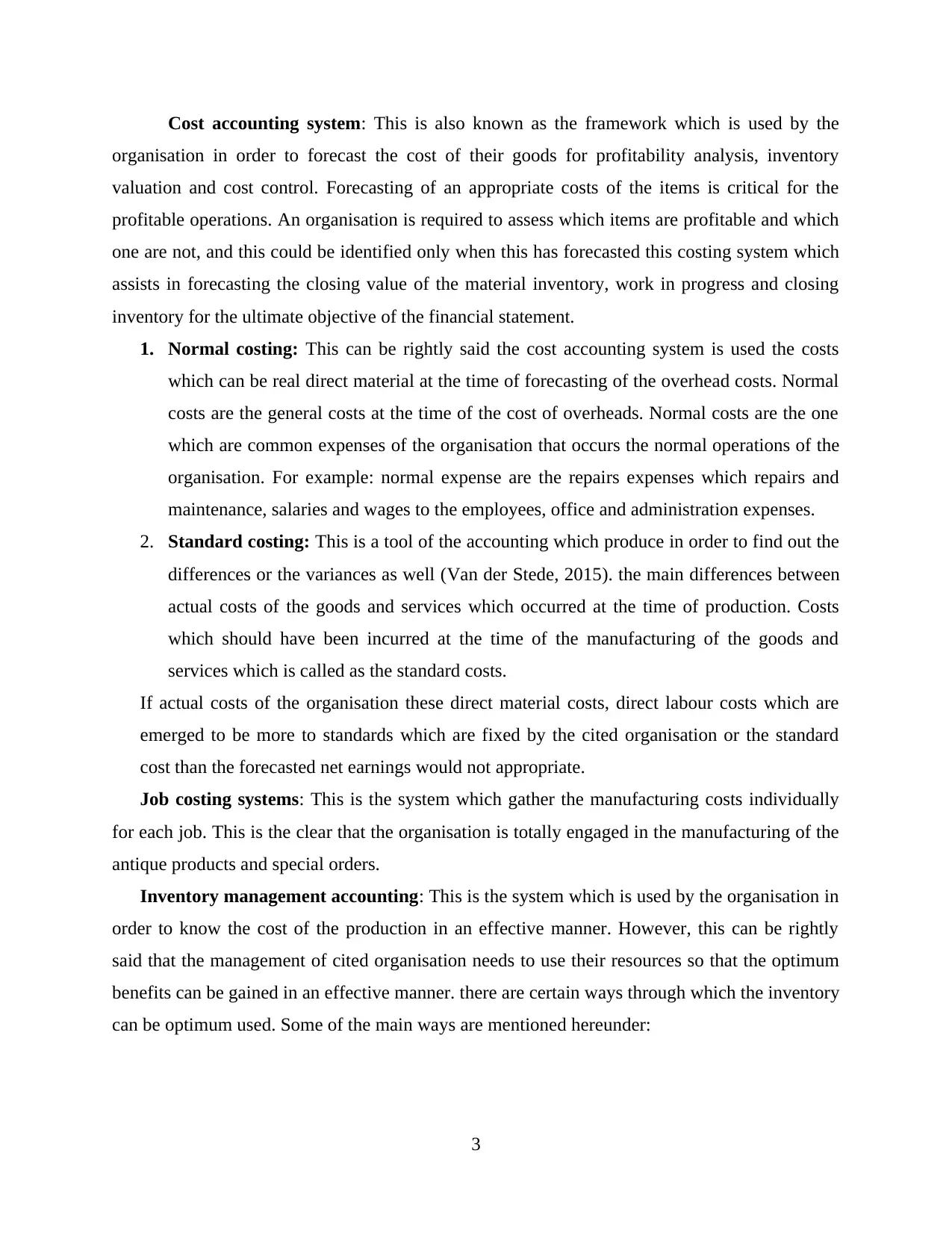
Cost accounting system: This is also known as the framework which is used by the
organisation in order to forecast the cost of their goods for profitability analysis, inventory
valuation and cost control. Forecasting of an appropriate costs of the items is critical for the
profitable operations. An organisation is required to assess which items are profitable and which
one are not, and this could be identified only when this has forecasted this costing system which
assists in forecasting the closing value of the material inventory, work in progress and closing
inventory for the ultimate objective of the financial statement.
1. Normal costing: This can be rightly said the cost accounting system is used the costs
which can be real direct material at the time of forecasting of the overhead costs. Normal
costs are the general costs at the time of the cost of overheads. Normal costs are the one
which are common expenses of the organisation that occurs the normal operations of the
organisation. For example: normal expense are the repairs expenses which repairs and
maintenance, salaries and wages to the employees, office and administration expenses.
2. Standard costing: This is a tool of the accounting which produce in order to find out the
differences or the variances as well (Van der Stede, 2015). the main differences between
actual costs of the goods and services which occurred at the time of production. Costs
which should have been incurred at the time of the manufacturing of the goods and
services which is called as the standard costs.
If actual costs of the organisation these direct material costs, direct labour costs which are
emerged to be more to standards which are fixed by the cited organisation or the standard
cost than the forecasted net earnings would not appropriate.
Job costing systems: This is the system which gather the manufacturing costs individually
for each job. This is the clear that the organisation is totally engaged in the manufacturing of the
antique products and special orders.
Inventory management accounting: This is the system which is used by the organisation in
order to know the cost of the production in an effective manner. However, this can be rightly
said that the management of cited organisation needs to use their resources so that the optimum
benefits can be gained in an effective manner. there are certain ways through which the inventory
can be optimum used. Some of the main ways are mentioned hereunder:
3
organisation in order to forecast the cost of their goods for profitability analysis, inventory
valuation and cost control. Forecasting of an appropriate costs of the items is critical for the
profitable operations. An organisation is required to assess which items are profitable and which
one are not, and this could be identified only when this has forecasted this costing system which
assists in forecasting the closing value of the material inventory, work in progress and closing
inventory for the ultimate objective of the financial statement.
1. Normal costing: This can be rightly said the cost accounting system is used the costs
which can be real direct material at the time of forecasting of the overhead costs. Normal
costs are the general costs at the time of the cost of overheads. Normal costs are the one
which are common expenses of the organisation that occurs the normal operations of the
organisation. For example: normal expense are the repairs expenses which repairs and
maintenance, salaries and wages to the employees, office and administration expenses.
2. Standard costing: This is a tool of the accounting which produce in order to find out the
differences or the variances as well (Van der Stede, 2015). the main differences between
actual costs of the goods and services which occurred at the time of production. Costs
which should have been incurred at the time of the manufacturing of the goods and
services which is called as the standard costs.
If actual costs of the organisation these direct material costs, direct labour costs which are
emerged to be more to standards which are fixed by the cited organisation or the standard
cost than the forecasted net earnings would not appropriate.
Job costing systems: This is the system which gather the manufacturing costs individually
for each job. This is the clear that the organisation is totally engaged in the manufacturing of the
antique products and special orders.
Inventory management accounting: This is the system which is used by the organisation in
order to know the cost of the production in an effective manner. However, this can be rightly
said that the management of cited organisation needs to use their resources so that the optimum
benefits can be gained in an effective manner. there are certain ways through which the inventory
can be optimum used. Some of the main ways are mentioned hereunder:
3
⊘ This is a preview!⊘
Do you want full access?
Subscribe today to unlock all pages.

Trusted by 1+ million students worldwide
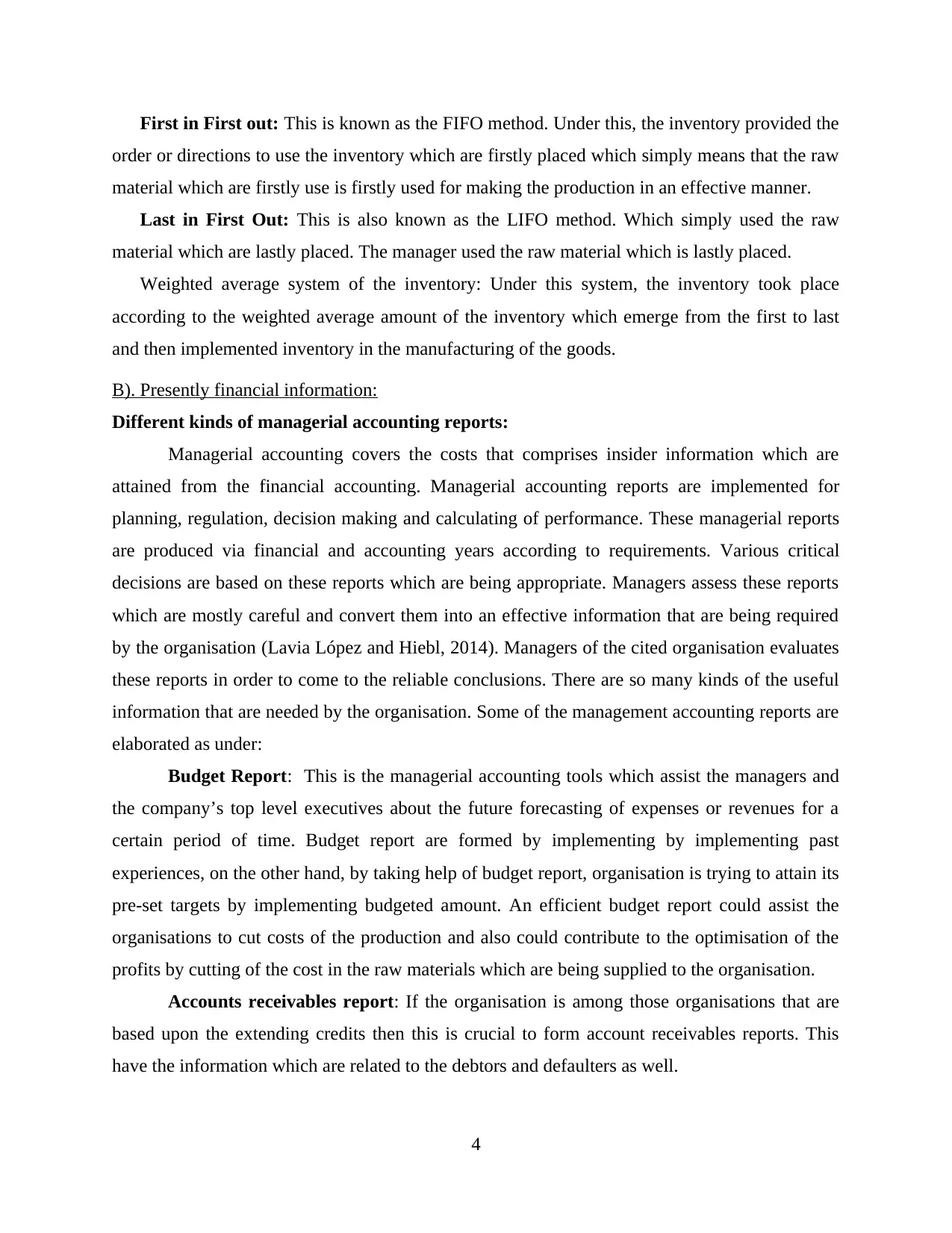
First in First out: This is known as the FIFO method. Under this, the inventory provided the
order or directions to use the inventory which are firstly placed which simply means that the raw
material which are firstly use is firstly used for making the production in an effective manner.
Last in First Out: This is also known as the LIFO method. Which simply used the raw
material which are lastly placed. The manager used the raw material which is lastly placed.
Weighted average system of the inventory: Under this system, the inventory took place
according to the weighted average amount of the inventory which emerge from the first to last
and then implemented inventory in the manufacturing of the goods.
B). Presently financial information:
Different kinds of managerial accounting reports:
Managerial accounting covers the costs that comprises insider information which are
attained from the financial accounting. Managerial accounting reports are implemented for
planning, regulation, decision making and calculating of performance. These managerial reports
are produced via financial and accounting years according to requirements. Various critical
decisions are based on these reports which are being appropriate. Managers assess these reports
which are mostly careful and convert them into an effective information that are being required
by the organisation (Lavia López and Hiebl, 2014). Managers of the cited organisation evaluates
these reports in order to come to the reliable conclusions. There are so many kinds of the useful
information that are needed by the organisation. Some of the management accounting reports are
elaborated as under:
Budget Report: This is the managerial accounting tools which assist the managers and
the company’s top level executives about the future forecasting of expenses or revenues for a
certain period of time. Budget report are formed by implementing by implementing past
experiences, on the other hand, by taking help of budget report, organisation is trying to attain its
pre-set targets by implementing budgeted amount. An efficient budget report could assist the
organisations to cut costs of the production and also could contribute to the optimisation of the
profits by cutting of the cost in the raw materials which are being supplied to the organisation.
Accounts receivables report: If the organisation is among those organisations that are
based upon the extending credits then this is crucial to form account receivables reports. This
have the information which are related to the debtors and defaulters as well.
4
order or directions to use the inventory which are firstly placed which simply means that the raw
material which are firstly use is firstly used for making the production in an effective manner.
Last in First Out: This is also known as the LIFO method. Which simply used the raw
material which are lastly placed. The manager used the raw material which is lastly placed.
Weighted average system of the inventory: Under this system, the inventory took place
according to the weighted average amount of the inventory which emerge from the first to last
and then implemented inventory in the manufacturing of the goods.
B). Presently financial information:
Different kinds of managerial accounting reports:
Managerial accounting covers the costs that comprises insider information which are
attained from the financial accounting. Managerial accounting reports are implemented for
planning, regulation, decision making and calculating of performance. These managerial reports
are produced via financial and accounting years according to requirements. Various critical
decisions are based on these reports which are being appropriate. Managers assess these reports
which are mostly careful and convert them into an effective information that are being required
by the organisation (Lavia López and Hiebl, 2014). Managers of the cited organisation evaluates
these reports in order to come to the reliable conclusions. There are so many kinds of the useful
information that are needed by the organisation. Some of the management accounting reports are
elaborated as under:
Budget Report: This is the managerial accounting tools which assist the managers and
the company’s top level executives about the future forecasting of expenses or revenues for a
certain period of time. Budget report are formed by implementing by implementing past
experiences, on the other hand, by taking help of budget report, organisation is trying to attain its
pre-set targets by implementing budgeted amount. An efficient budget report could assist the
organisations to cut costs of the production and also could contribute to the optimisation of the
profits by cutting of the cost in the raw materials which are being supplied to the organisation.
Accounts receivables report: If the organisation is among those organisations that are
based upon the extending credits then this is crucial to form account receivables reports. This
have the information which are related to the debtors and defaulters as well.
4
Paraphrase This Document
Need a fresh take? Get an instant paraphrase of this document with our AI Paraphraser
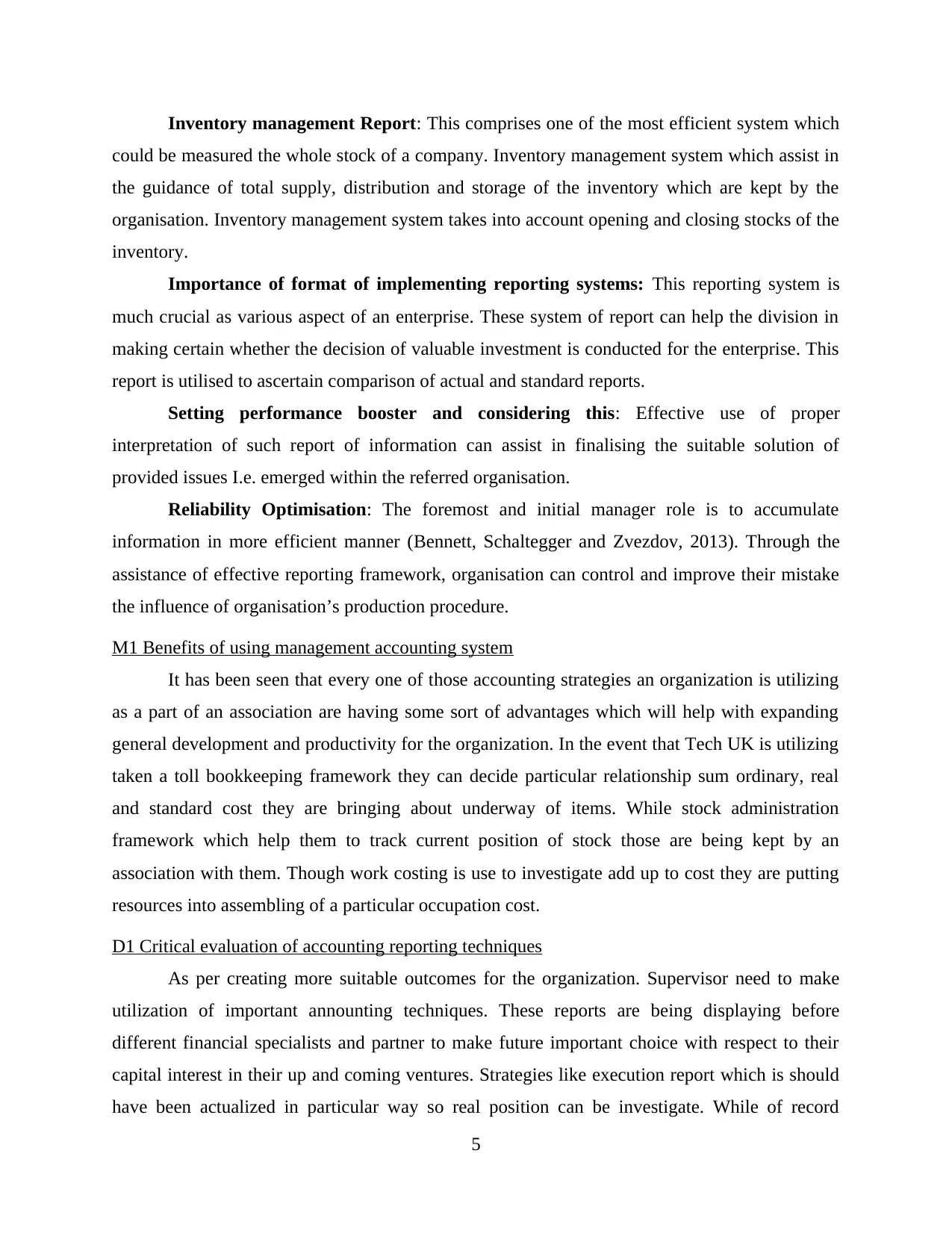
Inventory management Report: This comprises one of the most efficient system which
could be measured the whole stock of a company. Inventory management system which assist in
the guidance of total supply, distribution and storage of the inventory which are kept by the
organisation. Inventory management system takes into account opening and closing stocks of the
inventory.
Importance of format of implementing reporting systems: This reporting system is
much crucial as various aspect of an enterprise. These system of report can help the division in
making certain whether the decision of valuable investment is conducted for the enterprise. This
report is utilised to ascertain comparison of actual and standard reports.
Setting performance booster and considering this: Effective use of proper
interpretation of such report of information can assist in finalising the suitable solution of
provided issues I.e. emerged within the referred organisation.
Reliability Optimisation: The foremost and initial manager role is to accumulate
information in more efficient manner (Bennett, Schaltegger and Zvezdov, 2013). Through the
assistance of effective reporting framework, organisation can control and improve their mistake
the influence of organisation’s production procedure.
M1 Benefits of using management accounting system
It has been seen that every one of those accounting strategies an organization is utilizing
as a part of an association are having some sort of advantages which will help with expanding
general development and productivity for the organization. In the event that Tech UK is utilizing
taken a toll bookkeeping framework they can decide particular relationship sum ordinary, real
and standard cost they are bringing about underway of items. While stock administration
framework which help them to track current position of stock those are being kept by an
association with them. Though work costing is use to investigate add up to cost they are putting
resources into assembling of a particular occupation cost.
D1 Critical evaluation of accounting reporting techniques
As per creating more suitable outcomes for the organization. Supervisor need to make
utilization of important announting techniques. These reports are being displaying before
different financial specialists and partner to make future important choice with respect to their
capital interest in their up and coming ventures. Strategies like execution report which is should
have been actualized in particular way so real position can be investigate. While of record
5
could be measured the whole stock of a company. Inventory management system which assist in
the guidance of total supply, distribution and storage of the inventory which are kept by the
organisation. Inventory management system takes into account opening and closing stocks of the
inventory.
Importance of format of implementing reporting systems: This reporting system is
much crucial as various aspect of an enterprise. These system of report can help the division in
making certain whether the decision of valuable investment is conducted for the enterprise. This
report is utilised to ascertain comparison of actual and standard reports.
Setting performance booster and considering this: Effective use of proper
interpretation of such report of information can assist in finalising the suitable solution of
provided issues I.e. emerged within the referred organisation.
Reliability Optimisation: The foremost and initial manager role is to accumulate
information in more efficient manner (Bennett, Schaltegger and Zvezdov, 2013). Through the
assistance of effective reporting framework, organisation can control and improve their mistake
the influence of organisation’s production procedure.
M1 Benefits of using management accounting system
It has been seen that every one of those accounting strategies an organization is utilizing
as a part of an association are having some sort of advantages which will help with expanding
general development and productivity for the organization. In the event that Tech UK is utilizing
taken a toll bookkeeping framework they can decide particular relationship sum ordinary, real
and standard cost they are bringing about underway of items. While stock administration
framework which help them to track current position of stock those are being kept by an
association with them. Though work costing is use to investigate add up to cost they are putting
resources into assembling of a particular occupation cost.
D1 Critical evaluation of accounting reporting techniques
As per creating more suitable outcomes for the organization. Supervisor need to make
utilization of important announting techniques. These reports are being displaying before
different financial specialists and partner to make future important choice with respect to their
capital interest in their up and coming ventures. Strategies like execution report which is should
have been actualized in particular way so real position can be investigate. While of record
5
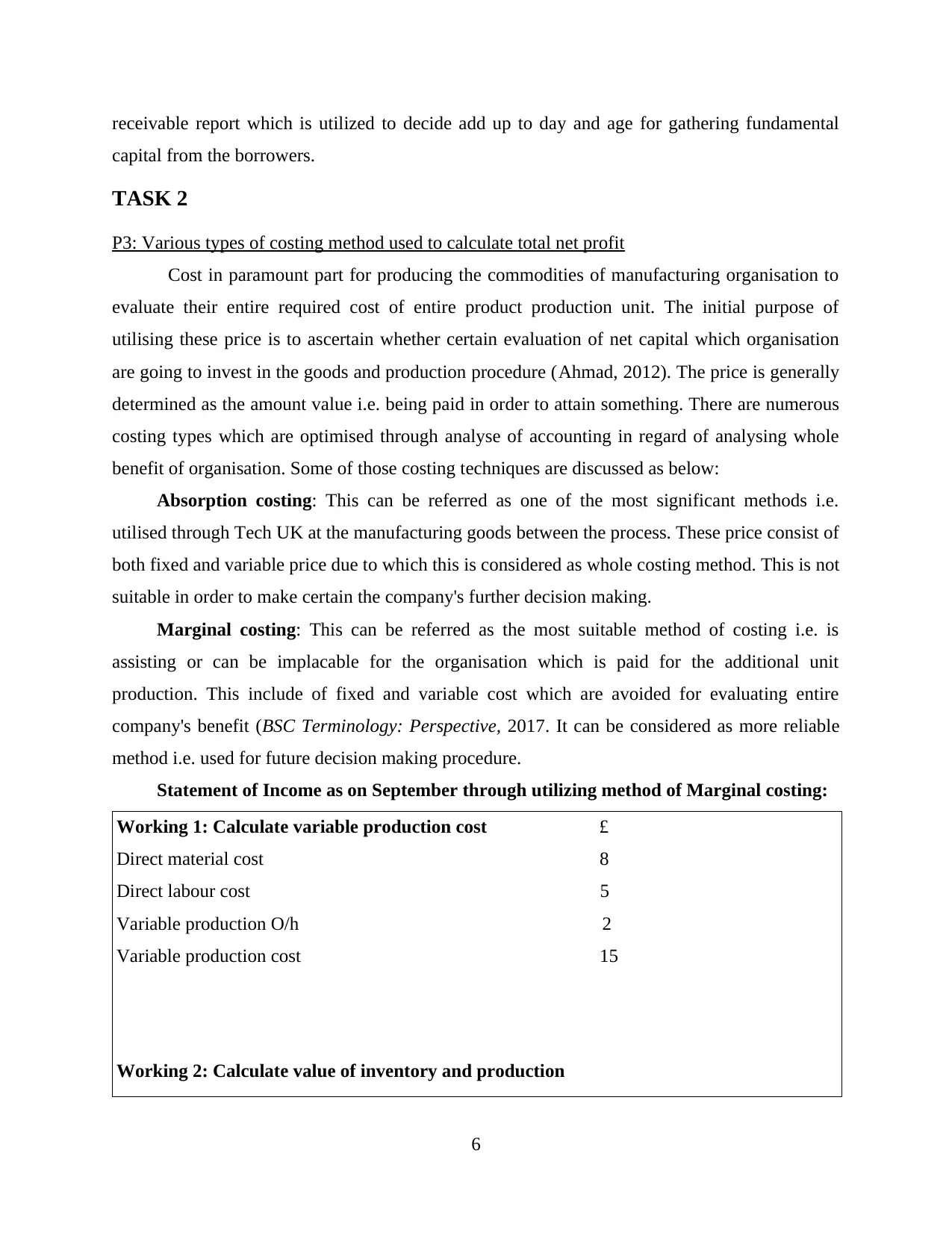
receivable report which is utilized to decide add up to day and age for gathering fundamental
capital from the borrowers.
TASK 2
P3: Various types of costing method used to calculate total net profit
Cost in paramount part for producing the commodities of manufacturing organisation to
evaluate their entire required cost of entire product production unit. The initial purpose of
utilising these price is to ascertain whether certain evaluation of net capital which organisation
are going to invest in the goods and production procedure (Ahmad, 2012). The price is generally
determined as the amount value i.e. being paid in order to attain something. There are numerous
costing types which are optimised through analyse of accounting in regard of analysing whole
benefit of organisation. Some of those costing techniques are discussed as below:
Absorption costing: This can be referred as one of the most significant methods i.e.
utilised through Tech UK at the manufacturing goods between the process. These price consist of
both fixed and variable price due to which this is considered as whole costing method. This is not
suitable in order to make certain the company's further decision making.
Marginal costing: This can be referred as the most suitable method of costing i.e. is
assisting or can be implacable for the organisation which is paid for the additional unit
production. This include of fixed and variable cost which are avoided for evaluating entire
company's benefit (BSC Terminology: Perspective, 2017. It can be considered as more reliable
method i.e. used for future decision making procedure.
Statement of Income as on September through utilizing method of Marginal costing:
Working 1: Calculate variable production cost £
Direct material cost 8
Direct labour cost 5
Variable production O/h 2
Variable production cost 15
Working 2: Calculate value of inventory and production
6
capital from the borrowers.
TASK 2
P3: Various types of costing method used to calculate total net profit
Cost in paramount part for producing the commodities of manufacturing organisation to
evaluate their entire required cost of entire product production unit. The initial purpose of
utilising these price is to ascertain whether certain evaluation of net capital which organisation
are going to invest in the goods and production procedure (Ahmad, 2012). The price is generally
determined as the amount value i.e. being paid in order to attain something. There are numerous
costing types which are optimised through analyse of accounting in regard of analysing whole
benefit of organisation. Some of those costing techniques are discussed as below:
Absorption costing: This can be referred as one of the most significant methods i.e.
utilised through Tech UK at the manufacturing goods between the process. These price consist of
both fixed and variable price due to which this is considered as whole costing method. This is not
suitable in order to make certain the company's further decision making.
Marginal costing: This can be referred as the most suitable method of costing i.e. is
assisting or can be implacable for the organisation which is paid for the additional unit
production. This include of fixed and variable cost which are avoided for evaluating entire
company's benefit (BSC Terminology: Perspective, 2017. It can be considered as more reliable
method i.e. used for future decision making procedure.
Statement of Income as on September through utilizing method of Marginal costing:
Working 1: Calculate variable production cost £
Direct material cost 8
Direct labour cost 5
Variable production O/h 2
Variable production cost 15
Working 2: Calculate value of inventory and production
6
⊘ This is a preview!⊘
Do you want full access?
Subscribe today to unlock all pages.

Trusted by 1+ million students worldwide
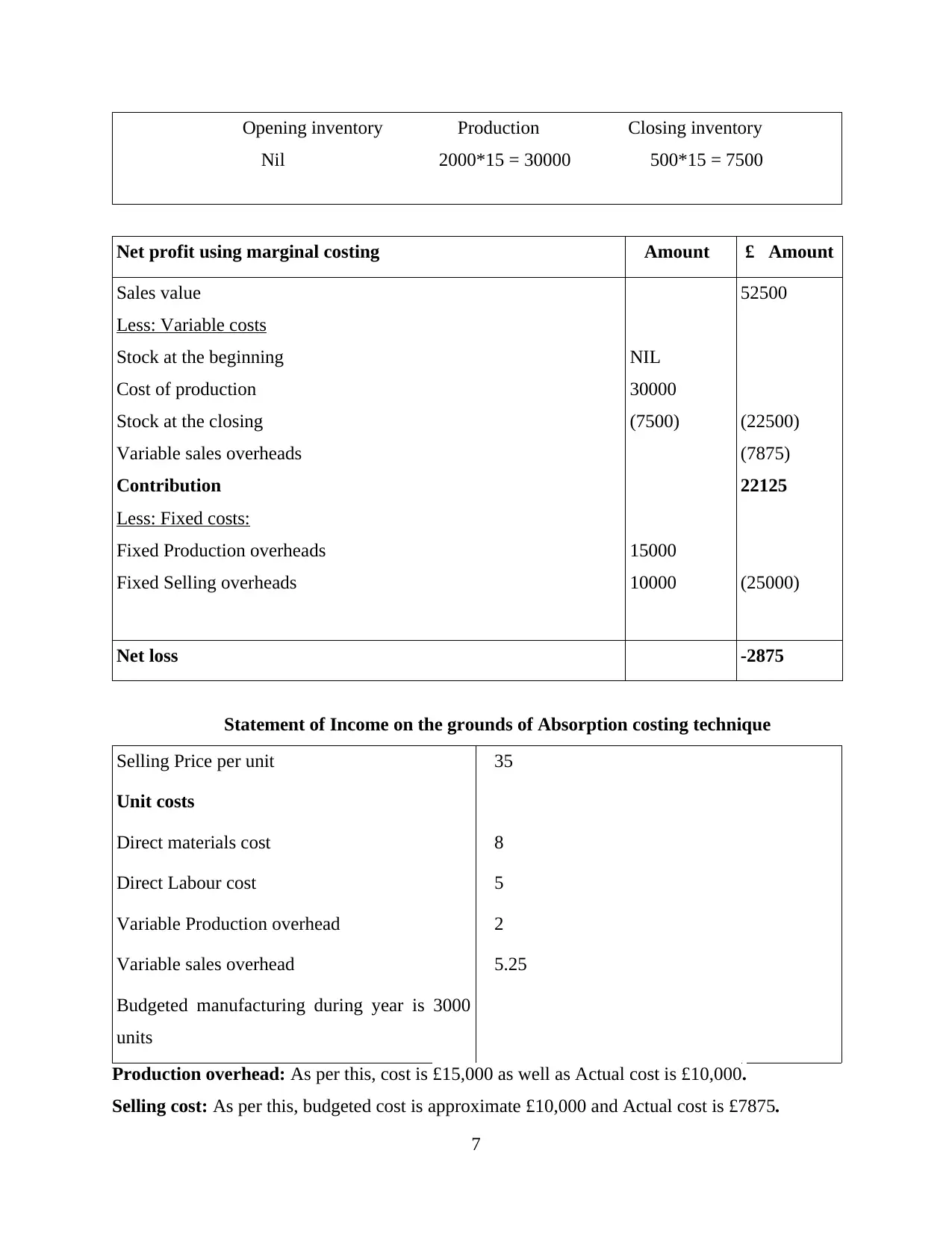
Opening inventory Production Closing inventory
Nil 2000*15 = 30000 500*15 = 7500
Net profit using marginal costing £Amount £ Amount
Sales value
Less: Variable costs
Stock at the beginning
Cost of production
Stock at the closing
Variable sales overheads
Contribution
Less: Fixed costs:
Fixed Production overheads
Fixed Selling overheads
NIL
30000
(7500)
15000
10000
52500
(22500)
(7875)
22125
(25000)
Net loss -2875
Statement of Income on the grounds of Absorption costing technique
Selling Price per unit £35
Unit costs
Direct materials cost £8
Direct Labour cost £5
Variable Production overhead £2
Variable sales overhead £5.25
Budgeted manufacturing during year is 3000
units
Production overhead: As per this, cost is £15,000 as well as Actual cost is £10,000.
Selling cost: As per this, budgeted cost is approximate £10,000 and Actual cost is £7875.
7
Nil 2000*15 = 30000 500*15 = 7500
Net profit using marginal costing £Amount £ Amount
Sales value
Less: Variable costs
Stock at the beginning
Cost of production
Stock at the closing
Variable sales overheads
Contribution
Less: Fixed costs:
Fixed Production overheads
Fixed Selling overheads
NIL
30000
(7500)
15000
10000
52500
(22500)
(7875)
22125
(25000)
Net loss -2875
Statement of Income on the grounds of Absorption costing technique
Selling Price per unit £35
Unit costs
Direct materials cost £8
Direct Labour cost £5
Variable Production overhead £2
Variable sales overhead £5.25
Budgeted manufacturing during year is 3000
units
Production overhead: As per this, cost is £15,000 as well as Actual cost is £10,000.
Selling cost: As per this, budgeted cost is approximate £10,000 and Actual cost is £7875.
7
Paraphrase This Document
Need a fresh take? Get an instant paraphrase of this document with our AI Paraphraser
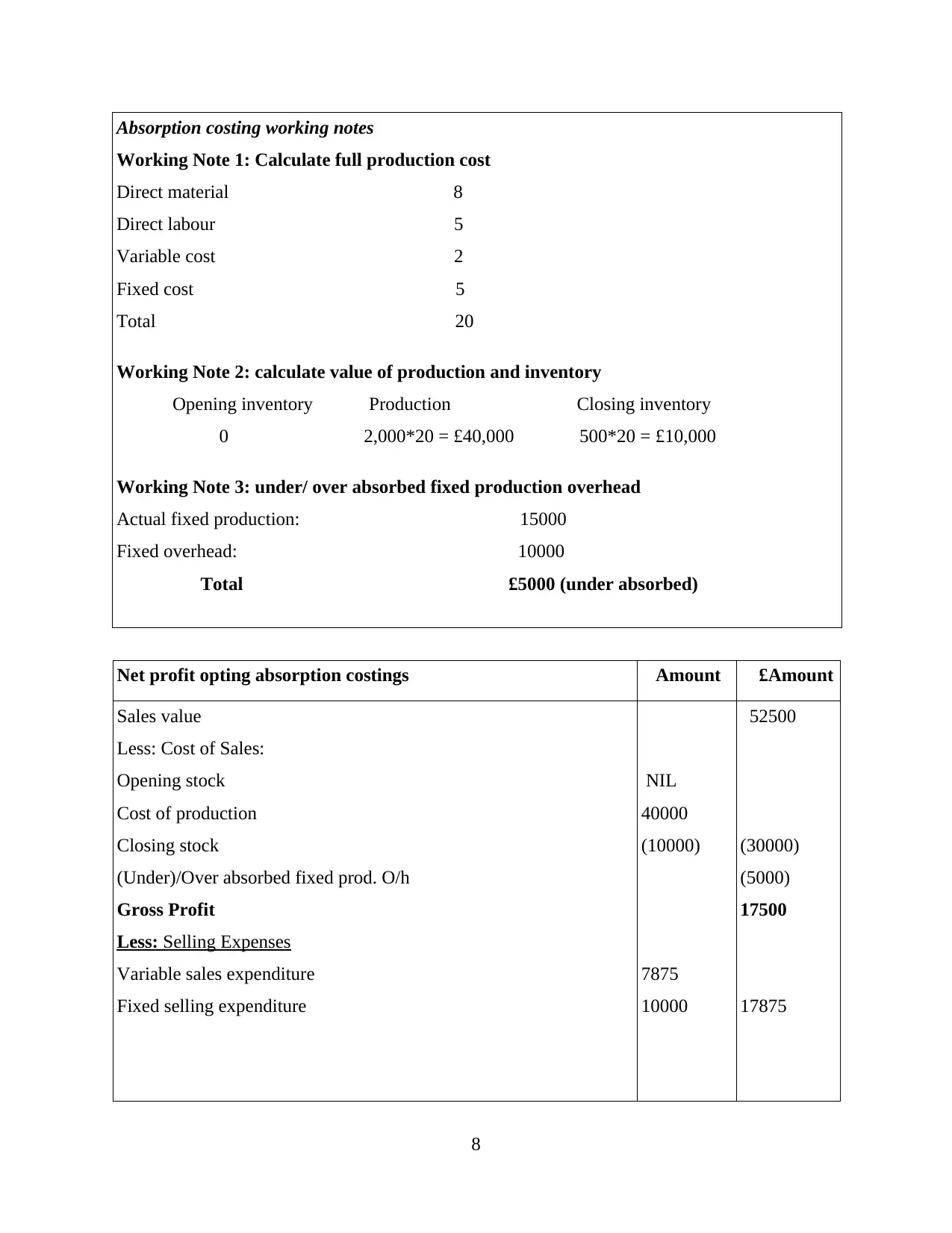
Absorption costing working notes
Working Note 1: Calculate full production cost
Direct material £8
Direct labour £5
Variable cost £2
Fixed cost £5
Total £20
Working Note 2: calculate value of production and inventory
Opening inventory Production Closing inventory
0 2,000*20 = £40,000 500*20 = £10,000
Working Note 3: under/ over absorbed fixed production overhead
Actual fixed production: £15000
Fixed overhead: £10000
Total £5000 (under absorbed)
Net profit opting absorption costings £Amount £Amount
Sales value
Less: Cost of Sales:
Opening stock
Cost of production
Closing stock
(Under)/Over absorbed fixed prod. O/h
Gross Profit
Less: Selling Expenses
Variable sales expenditure
Fixed selling expenditure
NIL
40000
(10000)
7875
10000
52500
(30000)
(5000)
17500
17875
8
Working Note 1: Calculate full production cost
Direct material £8
Direct labour £5
Variable cost £2
Fixed cost £5
Total £20
Working Note 2: calculate value of production and inventory
Opening inventory Production Closing inventory
0 2,000*20 = £40,000 500*20 = £10,000
Working Note 3: under/ over absorbed fixed production overhead
Actual fixed production: £15000
Fixed overhead: £10000
Total £5000 (under absorbed)
Net profit opting absorption costings £Amount £Amount
Sales value
Less: Cost of Sales:
Opening stock
Cost of production
Closing stock
(Under)/Over absorbed fixed prod. O/h
Gross Profit
Less: Selling Expenses
Variable sales expenditure
Fixed selling expenditure
NIL
40000
(10000)
7875
10000
52500
(30000)
(5000)
17500
17875
8
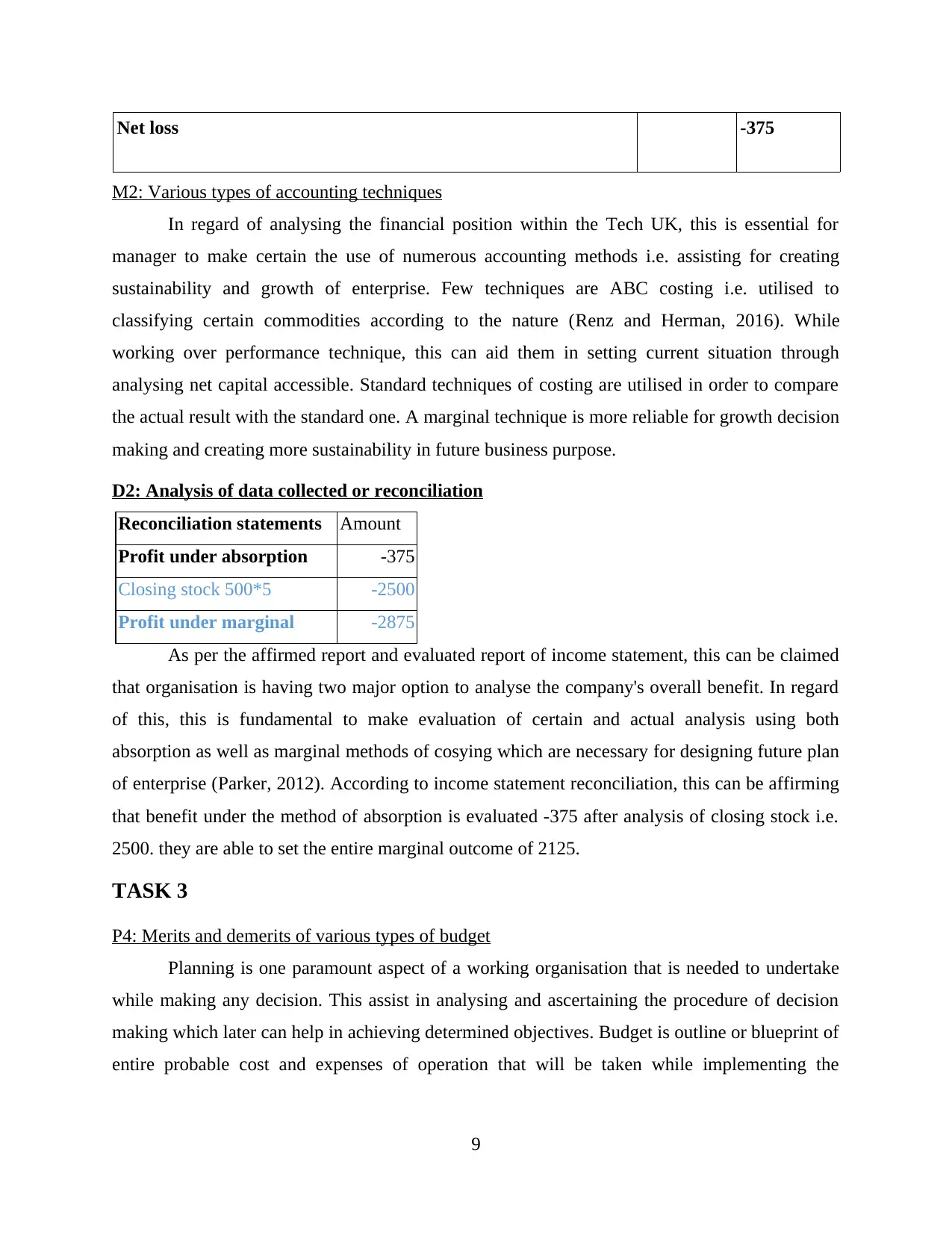
Net loss -375
M2: Various types of accounting techniques
In regard of analysing the financial position within the Tech UK, this is essential for
manager to make certain the use of numerous accounting methods i.e. assisting for creating
sustainability and growth of enterprise. Few techniques are ABC costing i.e. utilised to
classifying certain commodities according to the nature (Renz and Herman, 2016). While
working over performance technique, this can aid them in setting current situation through
analysing net capital accessible. Standard techniques of costing are utilised in order to compare
the actual result with the standard one. A marginal technique is more reliable for growth decision
making and creating more sustainability in future business purpose.
D2: Analysis of data collected or reconciliation
Reconciliation statements Amount
Profit under absorption -375
Closing stock 500*5 -2500
Profit under marginal -2875
As per the affirmed report and evaluated report of income statement, this can be claimed
that organisation is having two major option to analyse the company's overall benefit. In regard
of this, this is fundamental to make evaluation of certain and actual analysis using both
absorption as well as marginal methods of cosying which are necessary for designing future plan
of enterprise (Parker, 2012). According to income statement reconciliation, this can be affirming
that benefit under the method of absorption is evaluated -375 after analysis of closing stock i.e.
2500. they are able to set the entire marginal outcome of 2125.
TASK 3
P4: Merits and demerits of various types of budget
Planning is one paramount aspect of a working organisation that is needed to undertake
while making any decision. This assist in analysing and ascertaining the procedure of decision
making which later can help in achieving determined objectives. Budget is outline or blueprint of
entire probable cost and expenses of operation that will be taken while implementing the
9
M2: Various types of accounting techniques
In regard of analysing the financial position within the Tech UK, this is essential for
manager to make certain the use of numerous accounting methods i.e. assisting for creating
sustainability and growth of enterprise. Few techniques are ABC costing i.e. utilised to
classifying certain commodities according to the nature (Renz and Herman, 2016). While
working over performance technique, this can aid them in setting current situation through
analysing net capital accessible. Standard techniques of costing are utilised in order to compare
the actual result with the standard one. A marginal technique is more reliable for growth decision
making and creating more sustainability in future business purpose.
D2: Analysis of data collected or reconciliation
Reconciliation statements Amount
Profit under absorption -375
Closing stock 500*5 -2500
Profit under marginal -2875
As per the affirmed report and evaluated report of income statement, this can be claimed
that organisation is having two major option to analyse the company's overall benefit. In regard
of this, this is fundamental to make evaluation of certain and actual analysis using both
absorption as well as marginal methods of cosying which are necessary for designing future plan
of enterprise (Parker, 2012). According to income statement reconciliation, this can be affirming
that benefit under the method of absorption is evaluated -375 after analysis of closing stock i.e.
2500. they are able to set the entire marginal outcome of 2125.
TASK 3
P4: Merits and demerits of various types of budget
Planning is one paramount aspect of a working organisation that is needed to undertake
while making any decision. This assist in analysing and ascertaining the procedure of decision
making which later can help in achieving determined objectives. Budget is outline or blueprint of
entire probable cost and expenses of operation that will be taken while implementing the
9
⊘ This is a preview!⊘
Do you want full access?
Subscribe today to unlock all pages.

Trusted by 1+ million students worldwide
1 out of 17
Related Documents
Your All-in-One AI-Powered Toolkit for Academic Success.
+13062052269
info@desklib.com
Available 24*7 on WhatsApp / Email
![[object Object]](/_next/static/media/star-bottom.7253800d.svg)
Unlock your academic potential
Copyright © 2020–2025 A2Z Services. All Rights Reserved. Developed and managed by ZUCOL.





